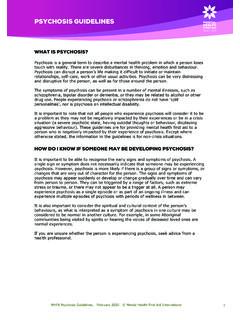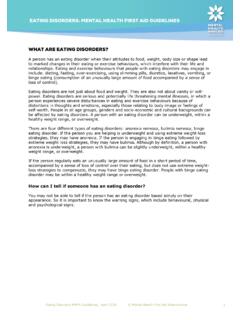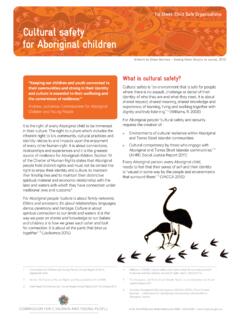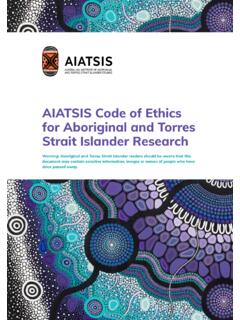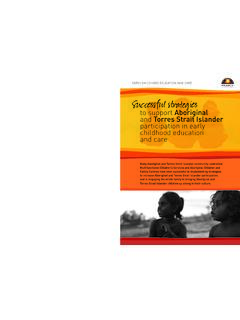Transcription of COMMUNICATING WITH AN ABORIGINAL OR TORRES …
1 GUIDELINES FOR PROVIDING MENTAL HEALTH FIRST AID TO AN ABORIGINAL OR TORRES strait ISLANDER PERSONCOMMUNICATING WITH AN ABORIGINAL OR TORRES strait ISLANDER ADOLESCENTAll MHFA guidelines can be downloaded from by Johanna ParkerPurpose of these guidelinesThese guidelines describe how members of the public should tailor their approach when providing mental health first aid to an ABORIGINAL or TORRES strait Islander adolescent who may be developing a mental illness or experiencing a mental health crisis. The role of the mental health first aider is to assist the young person until appropriate professional help is received or the crisis resolves. These guidelines include information on how first aiders can be respectful of cultural differences when assisting young document does not cover how to provide mental health first aid for specific mental illnesses or mental health crises.
2 Additional useful information can be found in: Youth Mental Health First Aid: A Manual for Adults Assisting young People ABORIGINAL and TORRES strait Islander Mental Health First Aid Manual Cultural Considerations & Communication Techniques: Guidelines for Providing Mental Health First Aid to an ABORIGINAL or TORRES strait Islander Person Depression: Guidelines for Providing Mental Health First Aid to an ABORIGINAL or TORRES strait Islander Person Psychosis: Guidelines for Providing Mental Health First Aid to an ABORIGINAL or TORRES strait Islander Person Suicidal Thoughts & Behaviours and Deliberate Self-Injury: Guidelines for Providing Mental Health First Aid to an ABORIGINAL or TORRES strait Islander Person Trauma and Loss: Guidelines for Providing Mental Health First Aid to an ABORIGINAL or TORRES strait Islander Person Problem Drinking: Guidelines for Providing Mental Health First Aid to an ABORIGINAL or TORRES strait Islander Person Problem Drug Use: Guidelines for Providing Mental Health First Aid to an ABORIGINAL or TORRES strait Islander PersonSpecific training on how to provide mental health first aid to young people is available in the 14-hour Youth Mental Health First Aid course.
3 Specific training on how to provide mental health first aid to ABORIGINAL or TORRES strait Islander people is available in the 14-hour ABORIGINAL and TORRES strait Islander Mental Health First Aid can purchase manuals, download guidelines and read about these courses at the Mental Health First Aid Australia website, of these guidelinesThe following guidelines are based on the expert opinions of ABORIGINAL mental health professionals from across Australia, who have extensive knowledge of, and experience in, the mental health of ABORIGINAL these guidelines are copyright, they can be freely reproduced for non-profit purposes provided the source is acknowledged.
4 Enquiries should be sent to Mental Health First Aid Australia: research was funded by the Australian Government Department of Health and to use these guidelinesIt is important to acknowledge that ABORIGINAL and TORRES strait Islander communities are not all the same; they may differ in their understanding, interpretations, approaches and treatment of mental illness. Be aware that the community that the adolescent lives in may not view mental illness in the same way that you these guidelines the word ABORIGINAL is used to represent all Australian ABORIGINAL and TORRES strait Islander these guidelines the word adolescent refers to an ABORIGINAL or TORRES StraitIslander adolescent.
5 There are a number of ways of defining adolescence and this may differ between communities. Here adolescence is defined as those aged between 12 and 18. However, adolescence can start earlier than 12 years and can continue through to the early 20s, so items in these guidelines could be relevant when helping people who are a little younger or older. When providing mental health first aid to an adolescent, first aiders need to use good judgment about whether the information is going to be appropriate for helping a person outside of the age range guidelines are a general set of recommendations about how you can best communicate with an ABORIGINAL adolescent who may be experiencing a mental illness or developing a mental health crisis.
6 Each individual is unique and it is important to tailor your support to the adolescent s needs. These recommendations therefore may not be appropriate for every adolescent. Be aware that these guidelines are not exhaustive and simply reading them will not equip you to be competent in providing assistance to ABORIGINAL cultural influencesBe aware of the impacts of culture and historySocial, cultural and historical factors all have an impact on the health and wellbeing of ABORIGINAL and TORRES strait Islander people. You should be aware of the adolescent s cultural background, local cultural norms and the hierarchy of decisionmaking power within their community.
7 It is important to recognise that there are cultural differences among ABORIGINAL and TORRES strait Islander should have a basic awareness of the historical invasion of Australia by Europeans and an understanding of the ongoing impact on the health and wellbeing of ABORIGINAL and TORRES strait Islander you are providing mental health first aid outside your own culture or community you should be culturally competent and practice cultural safety (see box below). You should not express any negative opinions about the adolescent s is important to recognise that no one is ever entirely culturally competent, as culture changes and evolves with time.
8 Even if you have not undertaken cultural awareness training (see box below), you should still provide mental health first aid to the ABORIGINAL adolescent, because any support, especially in a crisis, is better than AWARENESSC ultural awareness involves recognising that we are all shaped by our cultural background, which in turn influences how we interpret the world around us, perceive ourselves and relate to other people. It includes acknowledging past histories, policies and COMPETENCEC ultural competence focuses on the capacity of a person to apply cultural awareness and knowledge to their behaviours and attitudes. Being culturally competent involves behaviours and attitudes that reflect an awareness about: How a person s culture shapes their behaviour and how they understand health and ill-health The specific cultural beliefs that surround mental illness in a person s community How mental illness is described in a person s community, knowing what words and ideas are used to talk about the symptoms or behaviours Which concepts, behaviours or language are taboo and may cause shame (see the definition of shame next).
9 2 COMMUNICATING WITH AN ABORIGINAL OR TORRES strait ISLANDER ADOLESCENTSHAMEThe feeling of shame for an ABORIGINAL or TORRES strait Islander person is not easily defined and bears little or no resemblance to a dictionary definition. Shame can occur when a person is singled out or in a circumstance that directly targets a person s dignity. Shame may be felt as a result of: a lack of respect embarrassment self importance/self promotion rudeness a breach of accepted ABORIGINAL norms and/or taboosA shame job is an an event which causes a person shame or concept of shame is very important within many ABORIGINAL and TORRES strait Islander communities.
10 Shame can be overwhelming, disempowering and can also act as a barrier to seeking help. CULTURAL SAFETYP racticing cultural safety involves: Respecting the culture of the community by using appropriate language and behaviour Never doing anything that causes the person to feel shame Supporting the person s right to make decisions about seeking culturally based about the adolescent s cultural beliefs and concept of mental illness A person s culture plays a very important role in the way they understand and talk about mental health and mental illness, and how they go about seeking help from friends, family or professionals.
